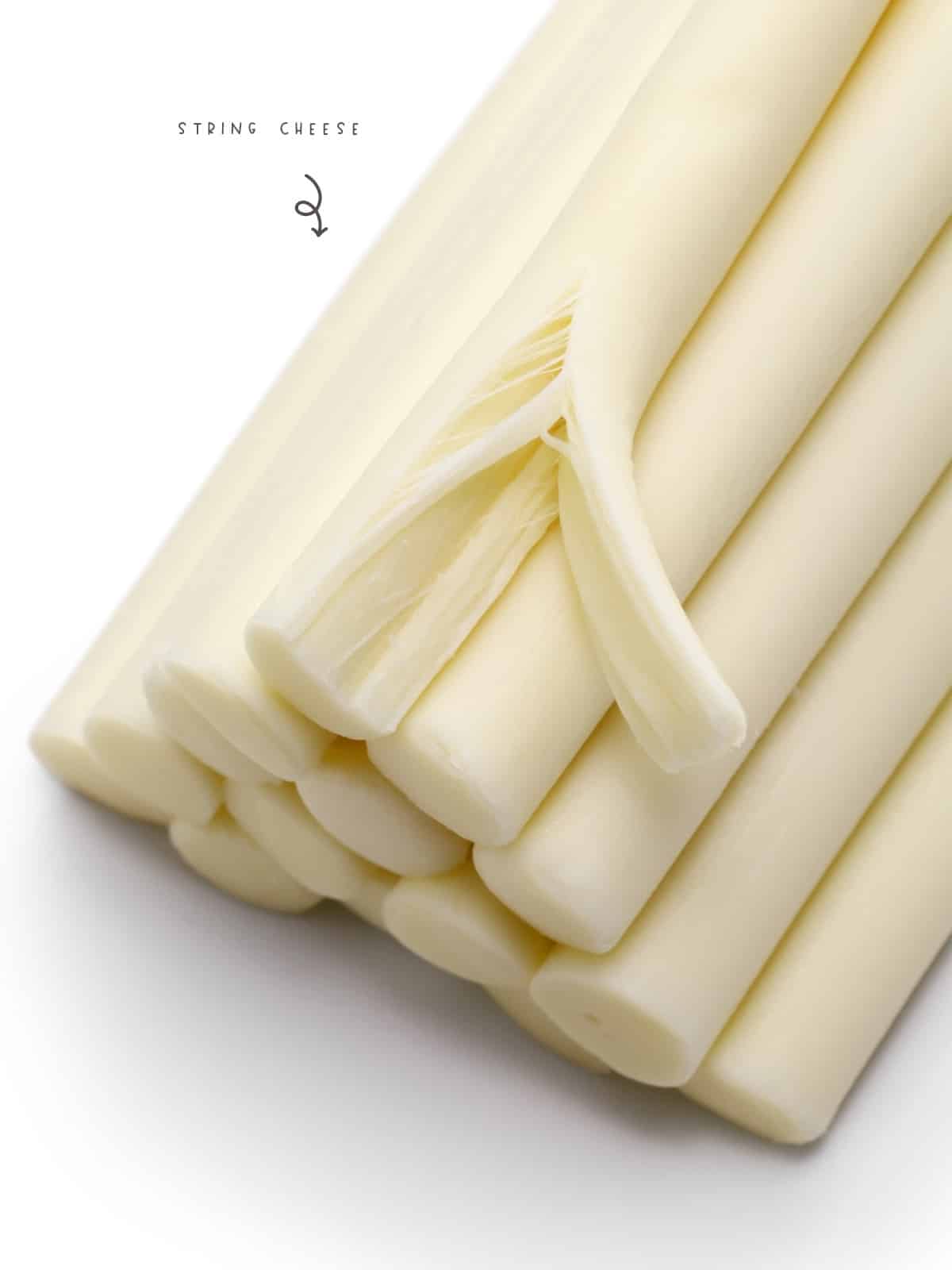String cheese is a fun, easy-to-eat snack perfect for the on-the-go. But what happens when there are leftovers? Can you freeze string cheese, or will it lose its shape and texture?
If you're a fan of string cheese, you'll be glad to know that you can freeze it and enjoy it later. Just make sure to thaw it out before eating it. Otherwise, you'll be in for a mouthful of freezer burn.
This article will discuss everything you need to know about freezing string cheese, including how to store it and thaw it out. We'll also provide some tips on how to avoid freezer burn.
If you're ready to learn more about freezing string cheese, let's first understand the basics of string cheese.

So, exactly what is string cheese?
In the US, string cheese is a type of low-moisture mozzarella cheese that's firm, has a slightly rubbery texture, and can be eaten as a snack or used as an ingredient. This form of string cheese is roughly cylindrical, with the size and shape of a mini hot dog or sausage. That's why it's perfect as a standalone or a post-workout snack since it's a good source of protein. String cheese is often packaged in plastic, wrapped in foil, or placed in a resealable bag that's easy to grab and go.
You'll find string cheese in the refrigerated section of your grocery store, typically near other types of cheese or lunch meats.
How is string cheese made?
Here's the thing about string cheese: it's made from mozzarella cheese. String cheese is low-moisture mozzarella cheese extruded into a long, thin strand. It's a type of processed cheese made with milk, culture, and rennet mixed and then heated to create a final product. The key ingredient in string cheese is rennet, an enzyme that helps the milk coagulate.
During mozzarella production, curds are heated to 140°F (60°C). Once it reaches that temperature, the milk proteins move around and line up together in a row. Upon reaching this point, the cheese becomes stretchy and pliable enough to shape into the dairy ball you see in the grocery store.
In this step, the process is slightly different: Instead of molding the mozzarella into balls, slices of mozzarella are cut and folded, stretched, and folded again. A pioneer in this field was Wisconsin cheesemaker Frank Baker.
You can use no other cheese to make string cheese apart from mozzarella. Any other cheese would not have the same elasticity or stretchiness, and wouldn't be able to be made into the same long, stringy shape, says Brian Baker, CEO of Baker Cheese. In other words, those cheese sticks available in the market are not string cheese. They're snack cheeses.
Can you freeze string cheese?
Yes, you can freeze string cheese! Freezing can help to preserve its freshness and flavor. There are two options for freezing string cheese: you can freeze the whole cheese, or you can slice it first. If you decide to freeze the whole cheese, wrap it tightly in plastic or aluminum foil. This will help to prevent freezer burn. String cheese can last in the freezer for up to two months.
If you slice the cheese first, you can store it in a resealable baggie or container. Again, label it with the date to know when you froze it.
You can store string cheese in the freezer for up to two months. When ready to eat it, thaw the cheese in the refrigerator overnight. Once it's melted, eat it within a few days.
Now that you know how to freeze string cheese, here are a few tips to avoid freezer burn:
- Wrap the cheese tightly in plastic wrap or aluminum foil.
- Label the cheese with the date you froze it.
- Store the cheese in the freezer for up to two months.
- Thaw the cheese in the refrigerator overnight.
- Eat the cheese within a few days of thawing.
Following these tips, you can enjoy your string cheese even after it's frozen. So go ahead and stock up on your favorite snack!
What is the difference between string cheese and mozzarella?
Although string cheese contains 100% mozzarella cheese, the two have different textures. String cheese gets its name from the stringy texture that results from how it is made. Mozzarella, on the other hand, has a smooth, creamy texture.
It is the method of preparation that makes the difference between the two. String cheese is made by stretching and kneading mozzarella cheese (made with low-moisture milk) until it forms long, thin strings. Mozzarella, on the other hand, is made by soaking in brine or water until they form a soft, pliable mass. Furthermore, fresh mozzarella only lasts a short while and tends not to melt well, but many appreciate its taste and texture.
Read:
String cheese also has a lower moisture content than mozzarella, which makes it less prone to spoilage. As a result, string cheese can be stored in the freezer for up to two months without affecting its quality. Mozzarella, on the other hand, should not be frozen as it will become crumbly and dry.
As a side note, mozzarella is the only cheese with "stringy" properties. Cheddar and other cheese sticks in the grocery store come in similar packaging, albeit they are imitations called "cheese snacks."
So, in a nutshell, string cheese is stretched mozzarella. Your kids can keep on eating it guilt-free in their lunch boxes. Now what's in those individually wrapped orange cheese slices is a mystery, and that's certainly a story for another time.
Why is it called string cheese?
String cheese is a type of cheese that is known for its stringy texture. This texture results from the cheese being stretched and pulled during manufacturing. String cheese gets its name from this unique texture.
String cheese is versatile and delicious in a variety of ways. It can be eaten as a snack, used in recipes, or even melted and used as a dipping sauce. A fun texture and mild flavor make string cheese popular for kids' meals.
How does string cheese get stringy?
Interestingly, the cheese-making process plays a big role in how the string cheese gets its characteristic stringiness. A stringy texture is naturally acquired by the cheese being stretched and pulled by a huge screw-shaped mixer known as an auger. This process is also known as extrusion.
The auger pulls and stretches the cheese while it is still in its liquid form until it forms into a long, stringy rope. This type of stretching and pulling aligns the proteins in the cheese, which results in that stringy texture when you bite into it.
Once it reaches the desired consistency, the cheese rope is cut into small pieces about 12 inches long. These pieces are then packaged and sold as string cheese. You can also find string cheese that has been pre-packaged in a long, string-like shape.
How come string cheese doesn't melt?
String cheese is made from a type of cheese called "mozzarella." Mozzarella is a "fresh" cheese, meaning it is not aged like many other types of cheese. Mozzarella is also a "low-moisture" cheese, meaning it has less water than different types of cheese. A string cheese's texture and flavor are unique because of this.
When heated, string cheese does not melt into a cheesy sauce. It's because string cheese has a very low-moisture content. Because of this, when the cheese is heated, the water inside the cheese begins to evaporate quickly. The evaporation of water causes the string cheese to become harder and more brittle. Low moisture prevents the string cheese from melting into a liquid form.
If you want to melt string cheese, it is best to slice it very thinly. This will allow the heat to penetrate the cheese better and melt it evenly. You can then use the melted string cheese to top pizzas, nachos, or any other dish you desire. Just be sure to enjoy it quickly, as the string cheese will begin to harden once it cools down.
Are string cheese and cheese sticks the same thing?
String cheese and cheese sticks are not the same things. Cheese sticks are usually made with cheddar cheese and are sold in stick form. String cheese is a type of mozzarella cheese available in individual pieces.
Cheese sticks are popular with adults because they are a convenient snack that you can eat without utensils. They are sold in similar packaging and are often confused with one another. They are both easy to grab and eat on the go. String cheese is a popular snack for kids because it is easy to eat and doesn't make a mess.
Related questions about string cheese
Does string cheese need to be refrigerated?
In the same way, you would store almost any other dairy product; string cheese must be kept in the fridge. The exception to this rule is if you're going to be consuming the string cheese within an hour or so of purchasing it, in which case you can keep it out at room temperature.
How long does string cheese last in the fridge?
String cheese can be kept in the fridge for up to two weeks, although you should consume it within a week of opening. Once you've opened the packaging, tightly reseal it or transfer the cheese to an airtight container.
You can freeze your string cheese's shelf life if you want to extend it. Frozen string cheese can last up to three months, although the quality will decline after the first month. When you're ready to eat the cheese, thaw it in the fridge overnight.
Can you melt string cheese?
Yes, you can melt string cheese, but it won't pool. String cheese is usually made with mozzarella, with a low-moisture content. That's why it's so stringy. When you melt it, the moisture will evaporate quickly, leaving you with a rubbery, chewy mass. This means that if you melt string cheese, it will become softer and more pliable, but it won't turn into a liquid you can pour.
If you're looking to create a stringy, melty cheese dish, your best bet is to use a cheese designed to melt, such as cheddar or Swiss. String cheese will melt if you cook it, but it won't have
Is string cheese healthy?
Yes, string cheese is a healthy snack option. It is a good source of protein and calcium and is lower in sodium than other types of cheese. Perfectly paired with crackers or fruit, string cheese makes a great snack for both kids and adults.
String cheese is made from mozzarella cheese, a cheese high in protein and calcium. String cheese also contains casein, a protein beneficial for building and maintaining muscle mass.
How many calories are in string cheese?
There are 80 calories in string cheese. String cheese is a good source of protein and calcium and is also low in fat. It also depends on the brand of string cheese. Some brands are higher in calories than others. If you're watching your calorie intake, be sure to check the label before you buy.
Are cheese strings fake cheese?
No, cheese strings are not fake cheese. They are a type of string cheese made from real milk. It is fun, easy to eat, and an excellent snack for kids fueling imaginations everywhere. So, the next time you are at the grocery store, remember to pick up a few packages of cheese strings! Your kids will love them in lunchboxes or as an after-school snack.




